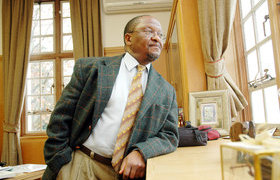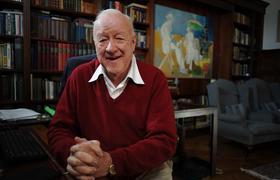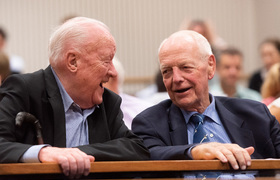Stuart Saunders: Farewell to the ‘king clinician’
25 February 2021 | Story Carla Bernardo. Photos University of Cape Town. Read time 9 min.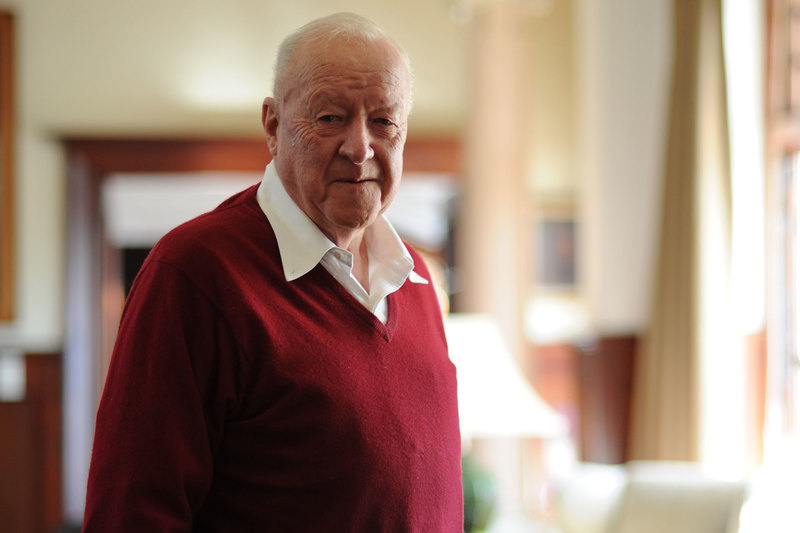
A champion of equality, adored by his students, the embodiment of civility and a bridge builder. These are just some of the ways in which former University of Cape Town (UCT) vice-chancellor Dr Stuart Saunders is remembered by friends, colleagues, students and the broader university community.
On Wednesday, 24 February 2021, UCT hosted a memorial service for its sixth vice-chancellor and former head of the Department of Medicine. Saunders’ children, John and Jane, noted that their father would have been pleased that it was held online because it made the event inclusive.
The speakers on the evening represented the calibre and diversity of those who joined to pay tribute and who shared their tributes since Saunders’ passing on 12 February: Vice-Chancellor Professor Mamokgethi Phakeng; Professor Ntobeko Ntusi, the chair and head of UCT’s Department of Medicine; Advocate Hermione Cronje, the head of the National Prosecuting Authority’s Investigating Directorate; Thulani Khanyile, the co-founder of the Manumit Corporation; Anglican archbishop Dr Thabo Makgoba; Mary Burton, a political activist; Emeritus Professor Solomon Benatar; and Babalwa Ngonyama, UCT’s Chair of Council.
UCT’s former registrar Hugh Amoore provided the welcome address and introductions, and shared reflections on behalf of Saunders’ children.
“We could not have done it without him. May his soul rest in peace.”
In her tribute, Professor Phakeng remembered Saunders for his outstanding contribution to higher education, his servant leadership and as a “champion of equality” who, amid turmoil, was a “nation builder”. She added that through his defiance of apartheid, he had displayed his patriotism; that he had stood on many frontlines; and had seen the future of a non-racial South Africa.
Phakeng concluded by thanking those who had supported Saunders to help realise his vision for higher education: “He’d be the first to say he could not have done it without you.
“Just as we know we could not have done it without him. May his soul rest in peace,” she said.
Encyclopaedic knowledge
Saunders spent his academic life in medicine, having graduated from UCT in 1953 with an MBChB with honours. He went on to do postgraduate research at the Royal Postgraduate Medical School at Hammersmith in London and at Harvard University. In 1965 he received the degree of Doctor of Medicine, again from UCT.
From 1971 to 1980 Saunders began his administrative career as head of UCT’s Department of Medicine. He was also the co-founder of the university’s Liver Clinic and Liver Research Unit.
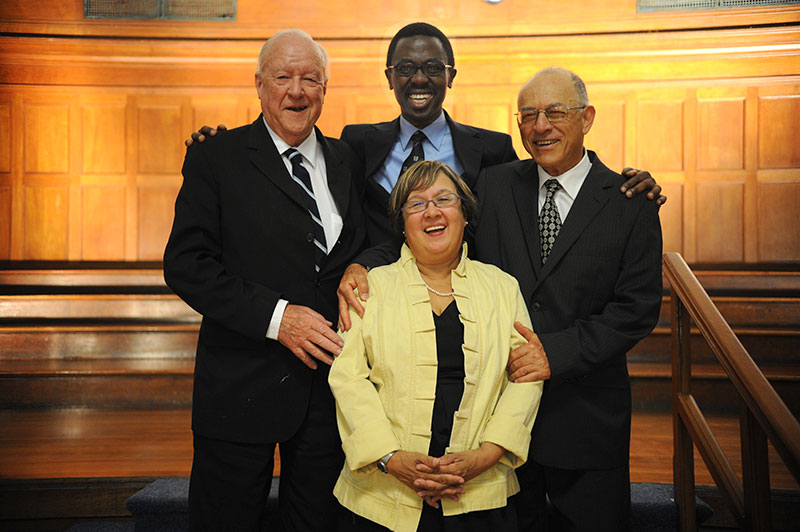
The department’s current head, Professor Ntusi, said that Saunders was adored by his students and had a knowledge of medicine that was “encyclopaedic”. Ntusi recalled how his mentor and friend would frequently call on his network to support Ntusi in whatever way necessary and that the former vice-chancellor was “generous to a fault”.
Bridge builder
Two former students who were at UCT during Saunders’ tenure as vice-chancellor shared their memories of his leadership during the dark days of apartheid. Khanyile and Advocate Cronje were student leaders in the late 1980s and early 1990s, during a period of “escalating and sustained resistance to apartheid”.
“Our hope ... is that current leaders of UCT, students and staff may learn from the consequential example of Dr Saunders and his team.”
In her tribute, Cronje recalled how, following a workers’ strike in 1991 and subsequent solidarity by, particularly, black students, she had witnessed Saunders’ “genuine acknowledgement” of how complicated and complex it was to be a student of colour at the university. She added that Saunders “represented a time and place in UCT’s history that [she is] proud to be associated with” and that he was “the bridge builder”.
Khanyile said that there were many lessons to be learnt from Saunders’ leadership.
“Our hope ... is that current leaders of UCT, students and staff may learn from the consequential example of Dr Saunders and his team, to listen deeply to one another and other key stakeholders in the university and the country [to] renew and take the university to new heights and embed further UCT among all our people.”
Another UCT graduate paying tribute was the Most Reverend Dr Makgoba, who served on a trust alongside Saunders. He said that during a recent meeting, it was “strange and painful” to not have Saunders there, motivating for financial support for postgraduates at resource-poor universities.
The Anglican archbishop, who paid tribute on behalf of the church, the Western Cape Religious Leaders Forum and the broader faith community, added that as someone who needed ministerial exemption to study at university, Saunders’ efforts to enrol black students were enormously important.
Beacon of inspiration
Burton, a long-serving member and former deputy chair of Council at UCT, said that Saunders “left an imprint on UCT which will endure” and that his was a “legacy of ethics, vision, academic excellence and courage”.
“He was purposeful and relentless in the pursuit of his dreams, as well as his selfless contribution to the university and the lives of many students.”
She also read a tribute on behalf of the David and Elaine Potter Fellowship, which will remember him as “a man of the Enlightenment, a polymath, student, doctor, scientist, intellectual, administrator, leader, civic activist and companion”.
Professor Benatar shared memories from his 55-year friendship and working relationship with Saunders. He remembered his friend and predecessor in the Department of Medicine as an excellent clinician and “a man of few words but a man of great action” who “maintained the common touch” and who was remarkable and unforgettable.
Benatar noted how, despite being a staunch supporter of the medical profession, Saunders was also critical of its shortcomings, an example of which was his resignation from the South African Medical Association for its failure to take disciplinary action against those involved in the treatment of Steve Biko.
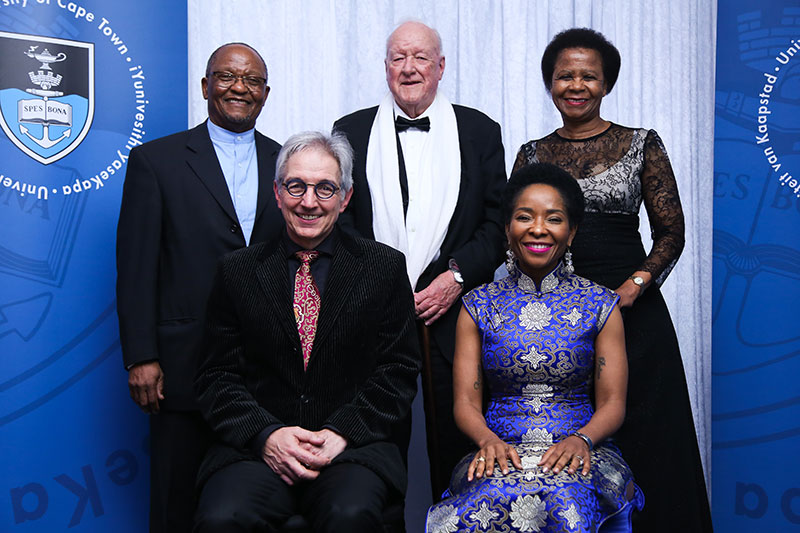
In her concluding remarks, Ngonyama spoke of Saunders’ many talents, which included his ability to work closely and in harmony with diverse personalities, stakeholders and even those with conflicting interests.
“Dr Saunders has left a meaningful footprint on this world. He was purposeful and relentless in the pursuit of his dreams, as well as his selfless contribution to the university and the lives of many students,” she added.
“His qualities of integrity, courage, excellence, humour and love are examples for all of us to follow; we will do our best to do that.”
“I have been moved by his life, and he continues to be a beacon of inspiration for others to pursue their path with vigour and dedication.”
Finally, in a written tribute, Saunders’ children thanked all who honoured and celebrated their father’s extraordinary life. They recalled how, among many other lessons, their parents ensured they were aware that “their comfort was not the norm for most South Africans”, impressed on them how “apartheid loomed, in all its horror, over people’s lives”, and that their father abhorred racism and bigotry.
“His qualities of integrity, courage, excellence, humour and love are examples for all of us to follow; we will do our best to do that,” they wrote.
“Thanks for all you gave us in your wonderful life, Dad. We love you. And we miss you terribly.”
 This work is licensed under a Creative Commons Attribution-NoDerivatives 4.0 International License.
This work is licensed under a Creative Commons Attribution-NoDerivatives 4.0 International License.
Please view the republishing articles page for more information.








